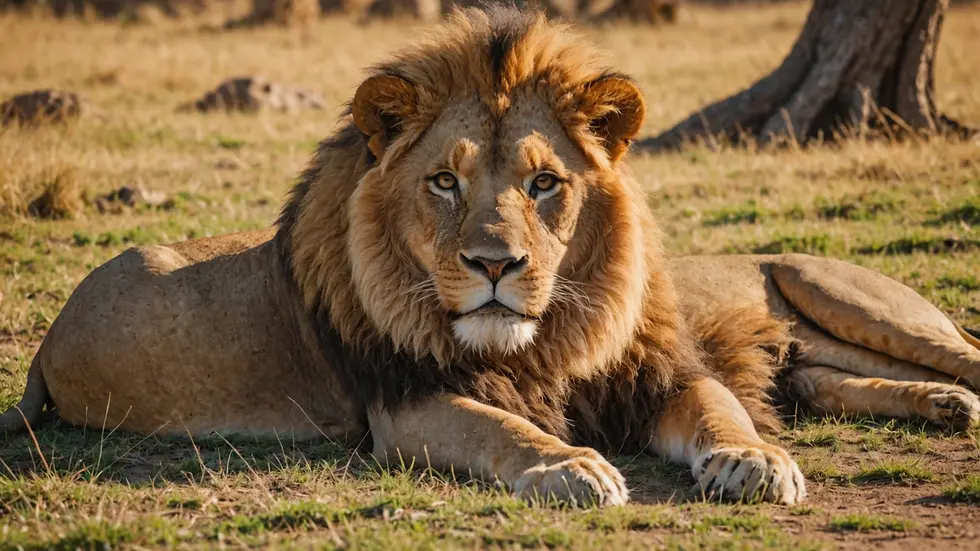Unveiling the Mysteries: A Comparative Analysis of Wild Cats and Domestic Cats
- Jyotiraj Borah
- Feb 5
- 5 min read
Cats are among the most fascinating creatures on our planet. The allure of wild cats, with their majestic presence, stands in stark contrast to the familiar charm of domestic cats that curl up on our laps. Whether you are a passionate cat owner or simply intrigued by these enigmas, understanding the differences and similarities between wild and domestic cats can deepen your appreciation for them.
In this post, we will examine key aspects such as anatomy, behavior, habitat, diet, and conservation. This exploration will reveal the fascinating contrasts and unexpected similarities between these two branches of the feline family.
Anatomy: Built for Different Worlds
When we envision cats, graceful movements, sharp claws, and keen senses usually come to mind. However, the anatomy of wild and domestic cats shows pronounced differences shaped by their lifestyles.
Wild cats, like lions, tigers, and leopards, are typically larger and more muscular. A lion's powerful forelimbs allow it to bring down prey that can weigh up to 500 pounds, while a cheetah's slender body, designed for incredible speed, can reach 60 to 70 miles per hour over short distances.

In stark contrast, domestic cats, like Siamese or Persian breeds, tend to have a smaller, more agile build. An average house cat weighs between 5 and 20 pounds, which aids in swift movements and lets them dart away from threats or ambush smaller prey, such as rodents or insects.
Behavior: Instincts in Action
The behavioral distinctions between wild and domestic cats are equally intriguing. Wild cats are driven by instinctual needs to hunt and survive, heavily influenced by their environments. For example, lions exhibit social behavior and live in prides comprising several females and their young, whereas leopards are generally solitary and prefer to roam alone.
Wild cats employ complex hunting strategies that involve stealth, speed, and strength. A lion may stalk by blending into the grass before charging, while tigers rely on ambush tactics. They communicate using vocalizations and scent marking, essential for maintaining territory.
In contrast, domestic cats have adapted to cohabitate with humans. They still exhibit predatory instincts through playful behaviors and the occasional hunt, but these actions are more about exercise and mental stimulation rather than survival.

Domestic cats display unique social behaviors like kneading, purring, and head-butting, which strengthen their bonds with humans. For instance, studies show that purring can lower stress levels in both cats and their human companions.
Habitat: Where They Call Home
Wild cats inhabit a variety of ecosystems, including jungles, savannahs, and deserts. Each species has adaptations suited to their environments. For instance, tigers thrive in tropical forests where their stripes help them blend into the shadows, facilitating effective hunting.
On the other hand, domestic cats have adapted to environments made by humans. They can be found in homes, farms, and urban areas, demonstrating remarkable adaptability. According to recent statistics, there are an estimated 600 million domestic cats worldwide, proving their popularity as pets.
Domestic cats often seek out warm, elevated spaces for rest, like furniture or sunny windowsills. Their ability to adapt has made them beloved companions across various cultures.
Diet: Carnivores at Heart
Both wild and domestic cats are obligate carnivores. This means their diet primarily consists of meat, though the way they obtain food differs significantly.
Wild cats are adept hunters, with diets tailored to their species. For instance, a lion hunts large herbivores, while a tiny wildcat preys on rodents or birds. Wild cats can consume up to 20 pounds of meat in a single meal, especially after a successful hunt.
Domestic cats, however, primarily rely on their humans for food. They typically consume commercial kibble or canned cat food, with nutritional values varying based on size, breed, and age. Recent surveys indicate that about 70% of cat owners choose commercial diets, while a growing number choose raw or homemade options to ensure dietary diversity.
Regardless of their diet, providing both wild and domestic cats with balanced nutrition is crucial for their health.
Lifespan: The Role of Environment
Longevity showcases another critical difference between wild and domestic cats.
Wild cats usually have shorter lifespans, mainly due to environmental dangers. For instance, lions may live around 10 to 14 years in the wild, often facing threats from other predators and diseases. In contrast, tigers have a similar lifespan.
Conversely, domestic cats often live much longer, typically ranging from 12 to 20 years with proper care. Secure food sources, regular veterinary check-ups, and the absence of natural predators contribute significantly to their extended lifespans.
Social Structures: Pack Behavior vs. Solitary Living
Social structures among wild cats vary greatly. Lions are unique in their social behavior, forming prides that cooperate in hunting and protecting their young. This communal living can involve up to 30 individuals, demonstrating strong pack dynamics.
Most other wild cats, such as tigers and leopards, display solitary behaviors. They are generally reclusive and prefer to hunt alone, except during mating seasons or maternal care of cubs. This independence aids in resource management and reduces competition.
Domestic cats, however, blend social and solitary traits. While they can live harmoniously in groups, they do not form packs like lions. They establish loose social hierarchies, often influenced by their experiences with humans and other pets.
Genetics: A Deep-rooted Connection
The genetic ties between wild and domestic cats inform many of their characteristics. All domestic cats share ancestry with the African wildcat, whose adaptability to human environments laid the foundation for modern breeds.
This domestication has led to about 70 recognized breeds, each exhibiting distinct traits while retaining essential instinctive behaviors. For example, the Maine Coon is known for its friendly demeanor, while the Abyssinian enjoys active play.
On the wild side, genetic variability is crucial for survival. Species have adapted uniquely to their habitats. For instance, the snow leopard possesses a thick coat suited for cold environments, while servals boast long legs for navigating tall grass.
Conservation: Protecting Wild Cats
Wild cats face significant threats, including habitat loss, poaching, and climate change. Conservation efforts are vital to their survival. Organizations work tirelessly to protect these magnificent creatures by preserving habitats, combating poaching, and raising awareness about their challenges.
At the same time, domestic cats also impact their wild counterparts. Free-roaming domestic cats pose risks to local wildlife, resulting in declines in native species. Responsible pet ownership—such as keeping cats indoors or using catios—helps mitigate these effects, promoting healthy ecosystems.
Final Thoughts: A Shared World
The comparison between wild and domestic cats unveils a rich tapestry woven from evolutionary threads. Both types of cats are fascinating but exist in vastly different realms.
Whether they are prowling through the wild or lounging in our homes, cats—both wild and domestic—continue to fascinate and enchant us. Understanding their unique behaviors, needs, and ecosystems enriches our connection with these creatures.
By prioritizing the conservation of wild cats and the responsible care of domestic cats, we can maintain a balanced coexistence between these extraordinary beings. The mystery of felines is more than just their beauty; it is the deep connection they forge with us and the vital roles they play in our world’s biodiversity. Both groups deserve appreciation and respect, thriving as integral parts of our shared environment.




Comments